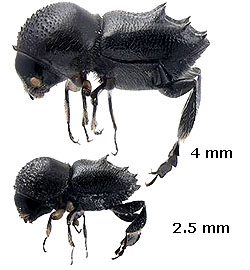Ambrosia Beetle Diversity

Fig: Example of a restricted host range of a regular bark beetle (left, Diamerus), and an unrestricted host range of ambrosia beetles (right, Dinoplatypus). The beetles were reared from trees representing a wide diversity of vegetation in lowland rainforests in New Guinea. From Hulcr et al. (2007b).
With about 3,200 species, ambrosia beetles are more diverse than any of the other fungus-growing insect groups. At least one ambrosia beetle group – the Xyleborini – has also been radiating at a conspicuous rate, producing 1,200 species in less than 30 million years (Farrell et al., 2001). Because they are all fungus farmers, it is tempting to conclude that this strategy is what caused their diversification. However, only three groups are really species rich (Platypodinae, Xyleborini and Corthylina). Most of the other ambrosia beetle groups are rather small, even though many have evolved sophisticated fungus agriculture. The question of ambrosia beetle diversity should thus be formulated as: why did the platypodines and xyleborines radiate so much?
Jiri Hulcr, Anthony Cognato, and the Binatang Center in New Guinea tested several possible factors that may have given rise to the hundreds of ambrosia beetle species in SE Asia:
- Co-diversification with their host trees?
- Limited dispersal and subsequent speciation across large distances (parapatric speciation)?
- Adaptations to different altitudes?
- Allopatric speciation due to geographic barriers?
Diversification with their plant hosts

Fig: Low beta diversity, or species turnover, in communities of ambrosia beetles in rainforests of New Guinea. From Hulcr et al. (2007b).
The hypothesis that an insect group co-diversified with their host plants assumes that individual insect species are at least to some extent specific to a restricted subset of the available plant hosts. We tested this assumption by rearing both ambrosia beetles and true bark beetles (the phloem-feeding relatives of ambrosia beetles) from a phylogenetically diverse set of trees in the lowland rainforests of New Guinea. We found that while the true bark beetles behave like most typical herbivores and are confined to their set of tree species (usually a taxonomic family), the ambrosia beetles just didn’t care (Hulcr et al., 2007a). Using ambrosia fungi as their source of food, the beetles can utilize almost any tree. Thus, they are unlikely to have diversified as a response to the diversity of trees. There are exceptional ambrosia beetles that are picky about their tree hosts, see the Ecology section.
Diversification through population disconnect over large distances
The hypothesis that ambrosia beetles diversified through the spread and break-up of populations (parapatric speciation) has the assumption that there is a sufficient decline for dispersion, or gene flow, between populations even without the presence of a major barrier. We also tested this, although in a roundabout way. We tested if the communities of ambrosia beetles are different in very distant localities in a contiguous rainforest. We found an almost complete lack of this community turnover, or beta diversity, in tropical ambrosia beetle communities. We sampled ambrosia beetle community on a 1000 km transect in Papua New Guinea, and found no statistically significant change along this distance (Fig. on the right; Hulcr et al., 2007b). At each locality, we nearly exhausted the local fauna, so even though some rare species may have limited distributions, most of the ambrosia beetles can be found simply everywhere throughout a contiguous rainforest. Thus, parapatric speciation, or dispersal limitation, is an unlikely source of new species in ambrosia beetles.
Diversification in different altitudes

Fig: Altitudinal diversification of an ambrosia beetle (Eccoptopterus spinosus). Top – a beetle from 1,500 m a.s.l., below – much smaller representative of the same species from the coast (50 m a.s.l.). Photo J.H.
Altitude actually seems to have played a significant role in structuring ambrosia beetle populations. We don’t have any rigorous analysis of this yet, but from my several collecting projects, it appears that species lists of ambrosia beetles from low altitudes overlap very little (about 2%) with those from high altitudes. And even in species which occur in both lowlands and highlands, there is a significant differentiation of morphology, most conspicuously in body size. Perhaps what we see is the actual process of divergence.
Allopatric speciation
There is no question that geographic barriers played a major role in the diversification of these beetles. Again, no formal analysis is available yet, but every significant collection can show the classic biogeographical pattern: while every species displays some variation within each island or continent, the communities are mostly homogenized. But look at the neighboring island, and the morphology of the species changes, and even farther islands harbor clearly different entities. Thus, archipelagos, such as those in South East Asia and Oceania, provide splendid parades of morphological diversity of all kinds of ambrosia beetles, often nicely correlated with geological relationships between their respective islands. Yet, the Amazon Basin in South America or the Congo Basin in Africa wield the same astounding diversity of ambrosia beetles, despite being covered with contiguous rainforests. What generated the diversity there is still a matter of conjectures, and an issue that we will hopefully get to address in my future projects.
In conclusion: the diversity of ambrosia beetles has not been generated by cospeciation with the tree hosts, neither by parapatric speciation of disjunct populations. It seems likely that factors such as the altitudinal differentiation, or allopatric speciation played more creative roles. Because of the unusual genetic setup of many ambrosia beetle groups, such as haplodiploidy, genetic or molecular-level phenomena may be more important, even if not as immediately apparent.
References
Farrell, B.D., Sequeira, A.S.O., Meara, B.C., Normark, B.B., Chung, J.H., & Jordal, B.H. (2001) The evolution if agriculture in beetles (Curculionidae: Scolytinae and Platypodinae). Evolution, 55, 2011-2027.
Hulcr, J., Mogia, M., Isua, B., & Novotny, V. (2007a) Host specificity of ambrosia and bark beetles (Col., Curculionidae: Scolytinae and Platypodinae) in a New Guinea rain forest. Ecological Entomology, 32, 762-772.
Hulcr, J., Novotny, V., Maurer, B.A., & Cognato, A. (2007b) Low beta diversity of ambrosia beetles (Coleoptera: Curculionidae: Scolytinae and Platypodinae) in lowland rainforests of Papua New Guinea. Oikos, 117, 214-222.
